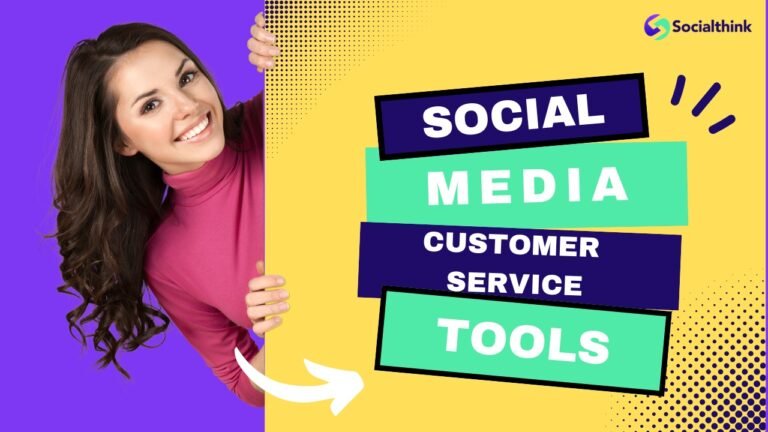10+ Social Collaboration Tools To Boost Your Team’s Efficiency in 2025
At Social Think, we understand the critical role social collaboration tools play in modern business operations. As experts in social media strategy and analytics, we’ve seen firsthand how these tools can transform team dynamics and drive business results.
In this comprehensive guide, we’ll explore the world of social collaboration tools, their benefits, and how to choose the right ones for your team.
What Are Social Collaboration Tools?

Social collaboration tools are software platforms that enable teams to work together more effectively, regardless of their physical location. These tools combine elements of social media, project management, and communication software to create a unified workspace for teams to share ideas, manage tasks, and collaborate on projects.
Benefits of Social Collaboration Tools

The benefits of using social collaboration software & tools in a team are many which are as follows:
- Improved Communication: Social collaboration tools break down communication barriers, allowing remote team members to interact seamlessly across departments and time zones. This improved communication leads to faster decision-making and problem-solving.
- Increased Productivity: By centralizing information and streamlining workflows, these tools significantly boost productivity. Teams can access all necessary resources in one place, reducing time spent searching for information or switching between applications.
- Enhanced Innovation: When teams can easily share ideas and collaborate in real time, innovation flourishes. Social collaboration tools create an environment where creativity can thrive, leading to new solutions and approaches.
- Crystal Clear Task Management: These tools often include robust task management features, making it easy for teams to assign, track, and complete tasks efficiently. This clarity helps keep projects on schedule and ensures everyone knows their responsibilities.
- Easier Onboarding: For new team members, social collaboration tools can significantly speed up the onboarding process. They provide a centralized location for company information, processes, and ongoing projects, allowing new hires to get up to speed quickly.
Top 10+ Social Collaboration Tools

Choosing the best social collaboration tools for your team depends on what you need most. You might need strong project management features.
You could also want easy ways to communicate. Or perhaps you’re looking for a platform that improves your creative work. There is a tool for every team’s needs.
Here are some top social collaboration tools. Each one has special features and benefits.
Slack

Slack is a powerful team collaboration software that centralizes team communication and project management. It allows users to create dedicated channels for different projects or topics, fostering transparent conversations and encouraging collaboration across diverse teams.
Slack supports real-time messaging, and file sharing, and integrates seamlessly with over 2,600 applications, enhancing workflow efficiency.
With features such as audio and video calling, automated workflows, and customizable notifications, Slack improves communication, boosts productivity, and facilitates content creation, making it essential for teams in today’s digital work environment.
Google Workspace

Google Workspace, formerly known as G Suite, is a comprehensive cloud-based productivity and collaboration tool designed for businesses and teams.
Its core applications include Gmail, Google Drive, Google Docs, Google Sheets, Google Slides, and Google Meet, which facilitate seamless communication, project management, and content creation.
Users can collaborate in real time, share files easily, and integrate tools for streamlined workflows, allowing for enhanced productivity and effective teamwork, whether in-office or remote.
Asana

Asana is a widely used, user-friendly web-based project management and collaboration tool that enables teams to centralize projects from long-term goals to daily tasks. It fosters team collaboration by allowing users to manage tasks, communicate, and track progress effectively.
With features such as project templates, task assignments, file sharing, and real-time updates, Asana enhances productivity and streamlines both project planning and execution.
It is beneficial for improving team collaboration, managing workflows, and ensuring deadlines are met efficiently, making it an ideal choice for both project management and content creation.
Trello

Trello is a user-friendly collaboration and project management tool that allows teams to organize tasks, workflows, and projects using visual Kanban boards.
It helps manage deadlines, assign tasks, and monitor progress, enhancing communication and collaboration among team members.
Trello integrates with various productivity tools and is flexible enough for personal use or larger organizations. With its intuitive drag-and-drop interface, Trello empowers users to increase productivity and streamline project management effectively.
Canva

Canva is a graphic design platform that offers an easy-to-use drag-and-drop interface, allowing users to create a variety of visual content, such as social media graphics, presentations, posters, and documents.
It features an extensive library of customizable templates, making it suitable for both beginners and professionals.
Canvas collaboration tools facilitate real-time teamwork and feedback, enhancing project management and workflow efficiency. This versatile tool supports various design needs, simplifying the content creation process for teams and individual users.
SocialPilot

SocialPilot is a robust social media management and collaboration tool designed to enhance team collaboration and streamline project management.
It enables users to automate social media posts, manage multiple accounts from a single dashboard, and collaborate on content creation with team members.
Key features include automated post-scheduling for optimal engagement times, a content calendar for easy planning, and tools for bulk scheduling and client approval processes.
This makes SocialPilot ideal for teams and agencies aiming to improve their social media marketing efforts, maximize productivity, and maintain a cohesive online presence.
Zoom

Zoom is a leading cloud-based video conferencing platform that enhances team collaboration and communication.
It features HD video and audio, making virtual meetings clear and effective. Users can share screens, use chat functions, and collaborate in real time, improving project management efficiency.
Zoom also integrates with various social media platforms, allowing teams to engage and share content easily.
Recent advancements include AI-powered features for meeting summaries and automated chat replies, which further streamline workflows and boost productivity. With support for both desktop and mobile devices, Zoom is designed for flexibility and accessibility, making it a popular choice for organizations of all sizes.
Airtable

Airtable is a cloud-based collaborative platform that merges the simplicity of a traditional spreadsheet with the powerful features of a database. It allows users to manage various tasks, including project management, content creation, and team collaboration.
Users can organize data in a visually appealing way, customize views, automate workflows, and seamlessly collaborate with team members.
Its features include task assignment, commenting, and integration with other software, making it an efficient tool for enhancing productivity and collaboration across projects.
Notion

Notion is a comprehensive productivity and collaboration tool that brings together note-taking, task management, and project organization into one platform.
It excels in real-time collaboration, allowing teams to edit documents, assign tasks, and leave comments simultaneously, which enhances communication and keeps everyone updated.
Notion’s customizable workspaces enable individuals and teams to tailor their environment to fit specific needs, streamline workflows, and improve content creation efforts.
With features that support project management and integration with other tools, Notion is ideal for both personal and team collaboration, making it a versatile solution for various productivity scenarios.
Monday.com

Monday.com is a cloud-based work operating system (Work OS) designed for seamless project management and team collaboration. It enables teams to manage tasks, track progress, and communicate effectively within a single platform.
Main features include customizable workflows, automation for repetitive tasks, real-time updates, time tracking, and comprehensive task management capabilities. The intuitive interface allows teams to assign tasks, set deadlines, and collaborate on projects efficiently, while its diverse application makes it suitable for various industries.
Users can easily share documents and feedback, fostering a productive workflow that enhances content creation and project management.
Microsoft Teams

Microsoft Teams is a powerful cloud-based collaboration tool that enhances communication and teamwork through features like real-time chat, video conferencing, and document sharing.
Integrated with Microsoft 365, it allows for efficient project management and content creation, making it ideal for remote and hybrid work environments.
With Microsoft Teams, teams can collaborate seamlessly from anywhere, fostering a productivity-driven culture and ensuring all members stay connected and informed.
Evernote

Evernote is a powerful collaboration tool that enhances productivity by allowing users to create and organize rich text notes, multimedia files, and to-do lists.
Its features include robust project management capabilities, advanced search functionality, and seamless synchronization across devices.
Evernote facilitates team collaboration and content sharing, making it an ideal tool for individuals and teams looking to streamline their workflows and improve communication.
With tagging and note organization features, users can easily manage their information and access it anytime, anywhere. Overall, Evernote serves as an essential tool for project management, team collaboration, and efficient content creation.
How Do Social Media Collaboration Tools Work?

Social media collaboration tools typically work by providing a centralized platform where team members can access shared resources, communicate, and work on tasks together. These tools often integrate with social media platforms, allowing teams to plan, create, schedule, and analyze social media content collaboratively.
What to Look For in Social Media Collaboration Tools?

- User-Friendly Interface: The tool should be intuitive and easy to navigate, reducing the learning curve for team members.
- Attractive Content Calendar: A visual content calendar helps teams plan and schedule social media posts effectively.
- Team Collaboration Features: Look for features like commenting, task assignment, and real-time editing that facilitate teamwork.
- Content Creation and Editing Tools: Built-in design tools or integrations with design software can streamline the content creation process.
- Analytics and Reporting: Robust analytics help teams measure the success of their social media efforts and make data-driven decisions.
- Multi-Platform Management: The ability to manage multiple social media accounts from a single dashboard is important for efficiency.
- Approval Workflows: Features that allow for content review and approval help maintain quality and consistency in social media posts.
- Integration Capabilities: The tool should integrate well with other software your team uses, such as CRM systems or project management tools.
- Social Listening and Engagement Tools: Features that help monitor brand mentions and engage with audience comments are valuable for social media teams.
- Scalability and Pricing: Consider whether the tool can grow with your team and if the pricing structure aligns with your budget.
- Security and Compliance: Ensure the tool meets your organization’s security requirements and complies with relevant data protection regulations.
- Customer Support and Resources: Good customer support and educational resources can help your team make the most of the tool.
How to Choose the Right Collaboration Tool For Your Team?

- Assess Your Team’s Needs: Identify the specific challenges your team faces and what features would address these issues.
- Consider Your Workflow: Choose a tool that aligns with your team’s existing processes or can help improve them.
- Evaluate Scalability: Ensure the tool can accommodate your team’s growth and evolving needs.
- Prioritize User Experience: A tool with a steep learning curve may hinder adoption and productivity.
- Check For Cross-Platform Support: If your team uses different devices or operating systems, choose a tool that works across all of them.
- Analyze Reporting Capabilities: Look for tools that offer detailed analytics to help you measure and improve your social media performance.
- Consider Content Creation Features: Built-in design tools or templates can save time and ensure brand consistency.
- Evaluate Collaboration Features: Features like real-time editing and commenting can significantly improve team collaboration.
- Investigate Security Measures: Ensure the tool has robust security features to protect your data and content.
- Read Reviews and Get Recommendations: Look for feedback from other users, particularly those in similar industries or with similar team sizes.
- Take Advantage of Free Trials: Most tools offer free trials. Use this opportunity to test the tool with your team before committing.
- Consider the Onboarding Process: Look for tools that offer comprehensive onboarding support to ensure smooth adoption.
- Think Long-Term: Consider how the tool might fit into your long-term social media strategy.
- Calculate ROI: Evaluate the potential return on investment by considering time saved and improved productivity.
Factors Influencing Pricing of Social Media Collaboration Tools

Pricing for social media collaboration tools can vary widely based on factors such as the number of users, features included, level of customer support, and the scale of social media management required for a social media manager.
Some tools enable collaboration among different teams, offering free plans with limited features, while others have tiered pricing structures that increase with team size and functionality.
Best Practices For Using Social Collaboration Tools

- Establish Clear Guidelines: Create and communicate clear guidelines for how the tools should be used within your organization.
- Encourage Active Participation: Promote regular use of the tools and recognize team members who contribute actively.
- Provide Training and Support: Offer ongoing training and support to help team members make the most of the tools.
FAQ’s:
How Do Social Collaboration Tools Impact Teamwork?
Social collaboration tools enhance teamwork by improving communication, centralizing information, and facilitating real-time collaboration.
How Do Social Media Collaboration Tools Improve Productivity?
These tools streamline workflows, reduce time spent on manual tasks, and improve coordination among team members, leading to increased productivity.
Can Small Businesses Benefit From Social Media Collaboration Tools?
Absolutely. Social media collaboration tools can help small businesses manage their social media presence more efficiently, even with limited resources.
Can Social Collaboration Tools Replace Email?
While they can significantly reduce reliance on email, most organizations find that email still has its place alongside collaboration tools.
What Are The Main Security Concerns With Social Collaboration Tools?
Common concerns include data privacy, access control, and the security of shared files. It’s important to choose tools with robust security features and to implement proper usage policies.
Conclusion
Social collaboration tools have become indispensable for teams looking to improve their efficiency and effectiveness, especially in the realm of social media management.
At Social Think, we’ve seen how these tools can transform social media strategies and drive business results.
Carefully selecting and implementing the right tools for your team can enhance communication, boost productivity, and help you stay ahead in the competitive world of social media.
Remember, the key is to choose tools that align with your team’s needs and work processes. If you need help selecting or implementing social collaboration tools for your social media efforts, don’t hesitate to reach out to us at Social Think.
We’re here to help you use these powerful tools to achieve your social media goals.







